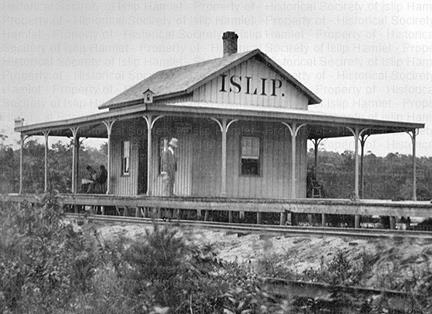This marker is located in the planter between the entrance and exit of the Islip Long Island Railroad station.
You can visit it now using Google Street View!
Google Street View
HISTORY 1 - ISLIP RAILROAD STATION
Any documentation of Islip Hamlet's railroad depot must necessarily deal with the history of two railroads: the Long Island Railroad, and one of its early competitors, the South Side Railroad, which was the first company to bring successful rail transportation to the well-established villages along the south shore in Nassau and Suffolk Counties between 1867 and 1876.
The Long Island Railroad's (LIRR) story begins in 1835 when the company leased the first railroad on the island, a 100 mile-long track running from Brooklyn to Jamaica. From that humble beginning, the LIRR's master plan was to have a rail line that would go from Jamaica, New York, clear through to Boston, Massachusetts, with passengers boarding a ferry at Greenport (L.I.) to deal with the inconvenience of the Long Island Sound. The railroad company was planning as well, to build its own road on the Connecticut side, a track that would run from Stonington to Boston. Connecticut's geography, however, (hills, valleys, rivers) conspired to make this idea unworkable. It was decided that an existing road, the Old Colony Railroad line, would serve instead.
The chosen destination of Greenport as the Long Island terminus for this interstate train route is the reason the first rail line into Nassau and Suffolk Counties was built through the largely deserted, central part of the island. These early eastbound trains leaving Jamaica were traveling through unpopulated pine forests, and as recorded in Paul Bailey's history of Long Island, they began stopping at "Farmingdale in 1841, Suffolk Station (near Brentwood) 1842, Yaphank, 1843, and finally Greenport in 1844." [1] The result was that the line was serving few inhabitants since the oldest and most populated settlements on the island were located on the west end and along its south shore. Those wishing to travel east by rail to the south shore, or west of Jamaica into Brooklyn, were forced to detrain at some deserted, middle-of-the-island station (or Brooklyn station on the west end) and achieve their destination by stage coach. Such trips could take days.
The situation changed dramatically when a Baldwin businessman, Charles Fox, took up the cause of bringing a line to the south shore. According to the Queens County Historian (and unofficial historian of the Long Island Railroad), Vincent F. Seyfried, when Mr. Fox approached then LIRR president, Oliver Charlick, and the Board of Directors with his idea of a road to, and along, the south shore, they were not interested. Mr. Fox, a wealthy man himself due to major real estate holdings in Manhattan, decided to lobby other men of means to support the project. A board of directors was formed who in turn, attracted more investors. At that time, the Civil War had stagnated the money market and caused a shortage of iron, but by 1865 conditions changed, and almost all the money needed to begin work on the rail line had been raised.
The new road was to be called the South Side Rail Road and Charles Fox became its first president. In 1866, bids went out for both preliminary work, and the laying of ties and rails over the 34 miles between Jamaica (going south to Freeport first and then along the south shore) and Islip, which was to be, according to the original plans, the eastern terminus. Ground was broken in May of 1866, and Seyfried writes that by September of that year it was decided to extend the terminus another eleven miles east of Islip, to the much larger village of Patchogue.
The work to build the South Side Railroad proceeded quickly, and generally unimpeded throughout the first two years--1866-67. During the good weather of 1867, about a half a mile of track could be laid each day with a number of crews working at different locations simultaneously. And then, on October 11, 1867, the rails reached Babylon. This is how Seyfried describes the reaction to that achievement in Part One of his documentation:
., .on the following day (after the rail reached Babylon) the Charles Fox (the company's first engine), with a passenger car attached containing the directors, passed over the road and were the recipients of numerous ovations at the different stations along the route. A brass band turned up at the Mineola Hotel where President Fox lay recovering from his injuries, (he slipped while trying to board a train that was still moving) and serenaded him, and he responded by inviting them all in for supper.
On Monday, October 28, 1867 the great day arrived, and trains began running regularly for the first time. The trains enjoyed heavy patronage and met enthusiastic receptions all along the line. The very first schedule provided for two trains a day each way, one in the morning and one in the afternoon. (The running time was one hour and fifteen minutes, and the stations and fares were as follows:)
Jamaica to...
On November 14, 1867, the South Side R.R. stage a formal grand opening of the completed road between Jamaica and Babylon. A five-car train was drawn up to the station and filled with the mayor, the whole Common Council, and prominent people of Brooklyn, plus the officers and directors of the South Side R.R. Other cars contained the prominent officials of Jamaica and Queens County, some Assemblymen from Albany and gentlemen of the press. The weather providentially turned out sunny and clear. After an hour's ride the train reached Babylon and the party was escorted to the American Hotel where "an elegant and sumptuous repast" 'was served Speeches were made by the more prominent guests, and the health of the absent president was toasted Later the guests sauntered about the streets of Babylon and then "took the cars" for Brooklyn. [2]
The positive support the railroad received from the very beginning went beyond success fill construction finances: 'The road cost $20,000 a mile including equipment; the company's capital was $1,250,000, of which $700,000 had already been expended. Popular enthusiasm along the line had resulted in the donation of several depot buildings. At Ridgewood (Wantagh) the depot had gone up by private subscription and the same thing was being done at Babylon. In addition much of the right of way had been donated outright by the farmers. [3]
The following year, the tracks were completed to Islip and the first trains arrived at the Islip Railroad Station on Saturday September 5, 1868. The reported fare from Jamaica to Islip between 1868 and 1872 was $1.35. Work continued until the road reached Patchogue a destination that could be reached for $1.65. Even that far out on the island, enthusiasm for the railroad was so high that the villages east of Patchogue were raising money, forming committees, and generally trying to persuade President Fox and the railroad's board to bring service as far as Eastport and perhaps beyond.
One of the reasons for South Side's success was its reasonable rates for both passengers and freight; lower than the Long Island Railroad, especially west of Jamaica. Another unquestionable draw was the fact that now, with a rail service to the south shore of Long Island, trapped city folk could very affordably and very quickly come out to the beautiful, villages along the bay and ocean, take in the sea breezes at a beach or waterside hotel, and enjoy an exceptional vacation-be it one day, a weekend, a week or more. There were however, no trains running on Sunday. This was a direct result of President Fox's position as a devout Baptist, and a board of directors who were used to observing the Sunday Sabbath as a day of inactivity. The policy, understandably, was more than an inconvenience to urban dwellers who were kept from desirable travel and recreation on their only day off.
Early in South Sides' short but effective history, it became clear to the board of directors that the efficient dispatching of trains would require a telegraph system. In 1868 they created a subsidiary called the South Side Telegraph Company. South Side did not, however, obtain contracts for mail deliveries to south shore villages until mid-1869.
It remains a curious fact (and one that accords a certain amount of prestige to the small hamlet of Islip) that Islip was originally chosen to be the terminal station for the South Side Railroad, even though Babylon and Bay Shore were larger villages, as was Patchogue, about ten miles to the east. No doubt the existence of the Doxsee clam factory. and the village's fishing industry and lumber-planing business contributed to Islip's significance as an essential depot.
It was a tradition to name each engine on the line (there was a total of 20 engines) and it has already been mentioned that South Side's first engine was the Charles Fox, in honor of the railroad's founder and first president. A number of them were named for the men who were officers of the railroad and others for localities. One of the last to be purchased in 1872-73 was named the Islip. Since there were only a handful of engines named for localities, this is perhaps another sign of Islip’s significance as a community.
HISTORY 2 - THE ISLIP RAILROAD STATION
The Islip Railroad Station, when first built, was a wooden-platformed structure with posts supporting an extended roof that afforded a protected area on all sides of the station room. It was modest, yet, because of its graceful supports, it was better looking than some of its immediate contemporaries. Located west of Islip Avenue on the south side of the railroad track (for many years there was just one track), it was later accompanied on the east by another building. Local resident, Stephen "Chet" Koerner, remembers that other building as the American Railway Express freight depot, which handled all railway shipping into Islip Hamlet. According to Mr. Koerner, even the owner of Islip Hamlet's local automobile agency, Frank Gates, would get his wares sent by rail---cars were shipped, unassembled---to the depot where they would be picked up and put together at the dealership on the north side of Main Street, west of Grant Avenue (where the Islip Pharmacy can be found today-2005).
Even though Islip first appears on South Side's schedule in May, 1868, the actual arrival of the first running train to the hamlet did not occur until September of that year. The event provided more than just excitement for townspeople; it promoted community pride as well as economic growth since it spurred tourism and benefited merchants and craftsmen who relied on rail shipments of materials and goods for their businesses. It also stimulated interested in the village's lovely bay front properties, making the area more appealing for development. It wasn't long before moneyed families from Brooklyn and Manhattan began building along the waterways, spending much of the year in their south shore "places," and hiring local folks for all types of work: carpenters, groundskeepers, gardeners, liverymen, cooks, and every other manner of domestic help. Obviously, the wealthy bought their supplies and groceries at local businesses as well further helping to build Islip into one of the busiest and most enterprising villages in Suffolk County by the turn of the century.



The Islip Depot had its share of stationmasters through the years but no records exist at the Long Island Railroad to identify them or their tenure, according to LIRR's Public Affairs Department. Information from long-standing Islip residents turned up the names of at least three local citizens who held that position: One was Joseph A. Moore, Sr. who served at the turn of the century (1901), but in the absence of documentation we cannot say for how long. According to a granddaughter, he was the Justice of the Peace in Islip at the same time. There is a photo of him in front of his insurance and real estate business on Main Street in Islip in 1904. Another stationmaster recalled by older residents is Frank Kroupa, who ran the freight depot at the station, and then moved to take charge of the station in the 1930's. He later became Superintendent of Highways for the Town of Islip and Stanley Jones took over the position of station manager.
In 1959, local architect Richard Boyd of South Bay Avenue in Islip, designed a new depot somewhat along the lines of the original (see 1878 photo). It featured a waiting room, rest rooms, and a station agent's service cage and office, and outside, a protective overhang supported by posts all around the building. The new station was built on the north side of the tracks, almost perfectly opposite its forerunners, and was renovated in 1997. Although beauty may still remain in the eye of the beholder, today's structure does not seem to hold nearly the quaintness and charm of those yesteryear buildings-not the fault of its design, which was handsomely colonial, but perhaps because it is awash in blacktop and metal fencing rather than natural surroundings. And, speaking of natural surroundings, a February, 1896 article in the Brooklyn Eagle (newspaper) refers to a large fox hunt on Washington's birthday that was to have its starting point at "the railroad house in Islip."
We here in Islip, (and all along the south shore for that matter) might still be serviced by the South Side Rail Road were it not for an unexpected reversal of fortune that hit the stock market in the 1870's. During the first days of 1873, the public was made aware of a business transaction that came as a distinct shock: the newspapers were blaring the fact that South Side's President Fox and his Board of Directors had sold their interest in the railroad to a Boston banking firm. That might not, in itseft: have been the death knell for the line, but in October of that year, a panic struck the stock market resulting in the closing of banking houses and causing a run on the banks. In the ensuing economic upheaval, the banking house of Jacob R Shipherd & Company, (the new owners of the road), was financially devastated and had to surrender the railroad. Court proceedings were instituted, and, since a number of mortgages had been given out to other railroads and businesses, serious financial and legal complications prevented any simple or timely resolution of the railroad's status. It was, however, doomed.
When the dust settled, the Long Island Railroad, with more financial assets than the three other successful railroads in the area, was given the task of merging all four former competitors into one operating unit. Still, it wasn't until 1880 that the old southern road, finally and officially, became the Montauk Branch of the Long Island Railroad, which is what it still is today. And of course today, we have but one railroad, The Long Island Railroad, providing all the rail service on Long Island.
Springfield
Pearsall's
Rockville Centre
Baldwinsville
Freeport
15¢
25¢
30¢
35¢
40¢
Merrick
Ridgewood
(Wantagh)
South Oyster Bay (Massapequa)
45¢
55¢
60¢
65¢
85¢
Amityville
Babylon
ISLIP DEPOT c1868
Islip Station c1910
Islip Station c1908
Nancy Porta Libert 2005


















